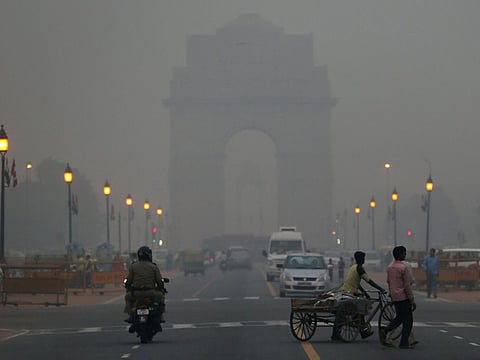Air pollution in Delhi drops 25% in four years
What does data show? How did the city achieve this?

India’s capital, Delhi is finally succeeding in its fight against air pollution.
In 2014, after the World Health Organisation conducted a global study on the air quality in various cities, it found Delhi to be the most polluted city in the world. However, Delhi’s lawmakers started taking quick steps to undo the damage. And, new data shows that they are heading towards success.
According to a report by The Indian Express, Delhi’s Chief Minister Arvind Kejriwal mentioned that the air pollution, especially the particulate matter of 2.5 micrometres (PM2.5) in Delhi has dropped by over 25 per cent in the last four years.
The Delhi CM cited the data from the Central Pollution Control Board (CPCB) and mentioned that between 2012 and 2014, the annual average PM 2.5 concentration was 154, which dropped to 115 between 2016 and 2018.
So how did Delhi lower the PM2.5 levels?
The 2014 study by IQ AirVisual, a Swiss-based group that gathers air-quality data globally, and Greenpeace had said that New Delhi’s toxic air is caused by vehicle and industrial emissions, dust from building sites, smoke from the burning of rubbish and crop residue in nearby fields.
Delhi, through its pollution control committee, started monitoring air quality in real time only in 2010. It started out with four stations — in R K Puram, Punjabi Bagh, Anand Vihar, and Mandir Marg. The number of stations was increased to 26 last year.
In 2012, Delhi saw its worst air quality, a senior official of the Delhi Pollution Control Committee (DPCC) said. “We felt the full force of crop-residue burning that year, especially in October and November. It was the first time that this burning was seriously flagged. We realised this was a big reason for the sudden dip in air quality in Delhi,” he said.
What is crop burning?
In the two months of October and November, Delhi's air quality is affected by smoke from thousands of fires as farmers burn crop stubble. They do so to hurry to switch their fields from fully grown rice to newly planted wheat in the span of a month. Particle pollution in the city in these months spiked to more than 30 times the limit prescribed by the World Health Organization.
According to a government-sponsored study, stubble burning contributed 26 percent of the most harmful particulate matter to Delhi's winter pollution during 2013 to 2014; another found it contributed as much as 50 percent on certain days during the burning season.
Such particulate matter — referred to as PM2.5 — is 30 times as thin as a human hair and can penetrate deep within the lungs.
The government brought measures into place. They shuttered the last coal-fired power plant in Delhi and banned the use of certain industrial fuels within the city.
On days when the pollution soared, other measures kicked in, such as a halt to all construction activities and a ban on trucks entering Delhi.
In 2016, Delhi also introduced the odd and even system in which private vehicles could be on the road only on certain days, depending on their license plate number. The scheme aimed to reduce pollution and smog in Delhi.
Drop in levels of PM10 too
According to ndianexpress.com: "Between 2012 and 2018, the concentration of PM10 reduced by 21% from an average 351 micrograms/cubic m to 277 micrograms/cubic m. PM10 is more prominent in the air in winter, primarily because of open burning and road and construction dust."
"Until August this year, Delhi’s performance in terms of PM10 concentration has been encouraging. In August, the average concentration fell to double digits for the first time since 2012; in 2013, this figure was as high as 288 micrograms/cubic m."
Why are the PM levels a concern?
Fine particles (PM2.5) pose the greatest health risk. These fine particles can get deep into lungs and some may even get into the bloodstream. Exposure to these particles can affect a person's lungs and heart. Coarse particles (PM10-2.5) are of less concern, although they can irritate a person's eyes, nose, and throat.
Delhi CM thanks residents and asks for suggestions
According to the Indian Express report, Kejriwal added:"At a time when pollution is increasing across cities in the country, it is declining in Delhi. This despite the fact that population and traffic in Delhi have increased. Steps being taken in the last few years appear to be working in the right direction. We want to thank the central government, MCDs, the Supreme Court… and the people of Delhi. We have achieved this together."
With the winters approaching, Kejriwal has also sought suggestions from the citizens on how to tackle air pollution when farmers in neighbouring states set fire to crop residues and toxic fumes start entering the city.
Sign up for the Daily Briefing
Get the latest news and updates straight to your inbox

_resources1_16a0853c600_medium.jpg?w=320&auto=format%2Ccompress&fit=max)




